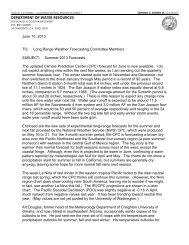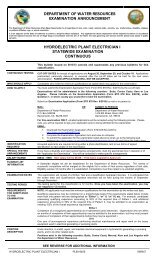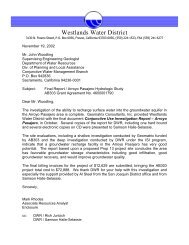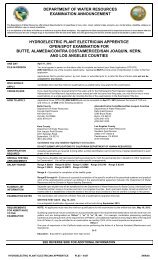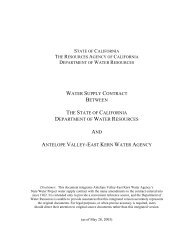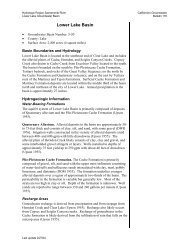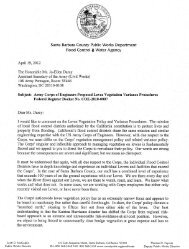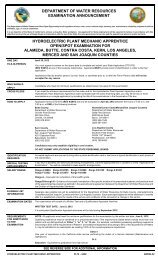Bulletin 1.pdf - California Department of Water Resources - State of ...
Bulletin 1.pdf - California Department of Water Resources - State of ...
Bulletin 1.pdf - California Department of Water Resources - State of ...
You also want an ePaper? Increase the reach of your titles
YUMPU automatically turns print PDFs into web optimized ePapers that Google loves.
WATER RESOURCES OF CALIFORNIA<br />
RELATED SUBJECTS<br />
For reasons later indicated, certain subjects relating in various<br />
degree to the water resources <strong>of</strong> <strong>California</strong> have been excluded from the<br />
scope <strong>of</strong> this bulletin.<br />
The relatively large water storage capacity <strong>of</strong> valley fills in <strong>California</strong><br />
comprises one <strong>of</strong> the more important natural resources <strong>of</strong> the<br />
<strong>State</strong>, its great value stemming from its natural regulation and conservation<br />
<strong>of</strong> precipitation and run<strong>of</strong>f. However, ground water storage<br />
capacity in itself is not an additional water resource, and has not been<br />
evaluated in the present inventory. It is briefly discussed in the ensuing<br />
section, "Natural Regulation <strong>of</strong> <strong>Water</strong> <strong>Resources</strong>."<br />
Recent technological advances have called attention to sea water<br />
conversion and to cloud seeding as possible means <strong>of</strong> adding to the water<br />
resources <strong>of</strong> <strong>California</strong>. Similarly, reclamation <strong>of</strong> sewage and waste<br />
waters for beneficial use, which already has been accomplished in certain<br />
instances, is under discussion and investigation. Possible augmentation<br />
<strong>of</strong> the water resources <strong>of</strong> the <strong>State</strong> by these methods has not been considered<br />
in the present inventory. However, the three methods are briefly<br />
discussed in ensuing sections, and a tentative evaluation <strong>of</strong> potential<br />
reclamation <strong>of</strong> sewage and waste water is contained in an appendix to<br />
this bulletin.<br />
Natural Regulation <strong>of</strong> <strong>Water</strong> <strong>Resources</strong><br />
The extensive ground water basins <strong>of</strong> <strong>California</strong> provide natural<br />
regulation for run<strong>of</strong>f from tributary mountain and foothill drainage<br />
areas, and for precipitation directly on overlying mesa and valley floor<br />
lands. More than half <strong>of</strong> the <strong>State</strong>'s water presently utilized on irrigated<br />
lands, and for domestic, municipal, and industrial purposes, is regulated<br />
in ground water basins.<br />
Additional natural regulation <strong>of</strong> water resources would be provided<br />
if presently unused ground water storage capacity were utilized to the<br />
full extent <strong>of</strong> safe yield <strong>of</strong> the ground water basins. Furthermore, as<br />
additional surface water supplies are developed and made available for<br />
storage in ground water basins, safe yield <strong>of</strong> the underground reservoirs<br />
will be increased. Under ultimate development <strong>of</strong> water resources in the<br />
<strong>State</strong>, the maximum amount <strong>of</strong> firm water could be made available on<br />
demand through operation <strong>of</strong> surface reservoirs on an average yield<br />
basis in conjunction with cyclic underground storage. Such coordinated<br />
operation would necessitate an adequate supply <strong>of</strong> energy to pump<br />
ground water in a series <strong>of</strong> dry years.<br />
Usability <strong>of</strong> a ground water basin as a natural regulator <strong>of</strong> water<br />
resources is dependent upon method and rate <strong>of</strong> replenishment <strong>of</strong> stored<br />
water, as well as extraction from the basin for beneficial use. The largest<br />
bodies <strong>of</strong> usable ground water storage capacity in <strong>California</strong> are in the<br />
Sacramento and San Joaquin Valleys in the Central Valley Area. Other<br />
important natural regulators <strong>of</strong> lesser magnitude are those in Santa<br />
Clara, Napa, Santa Rosa, and Livermore Valleys, and the Niles Cone in<br />
the San Francisco Bay Area; the Pajaro, Salinas, Santa Maria, and Santa<br />
Ynez River Basins in the Central Coastal Area ; the Ventura, Santa Clara,<br />
Los Angeles, San Gabriel, and Santa Ana River Basins in the South<br />
Coastal Area; Antelope, Owens, and Mojave Valleys in the Lahontan<br />
Area; and the Coachella Valley in the Colorado Desert Area.<br />
25



